Key takeaways:
- Artistic goals should reflect personal beliefs and guide the creative process, balancing aspirations with achievable steps.
- Setting realistic goals helps maintain motivation, resilience, and adaptability while navigating artistic journeys.
- Regularly evaluating and adjusting goals is essential for fostering growth and overcoming challenges in the creative process.
- Connecting with a supportive community and celebrating small achievements can significantly enhance motivation and creativity.
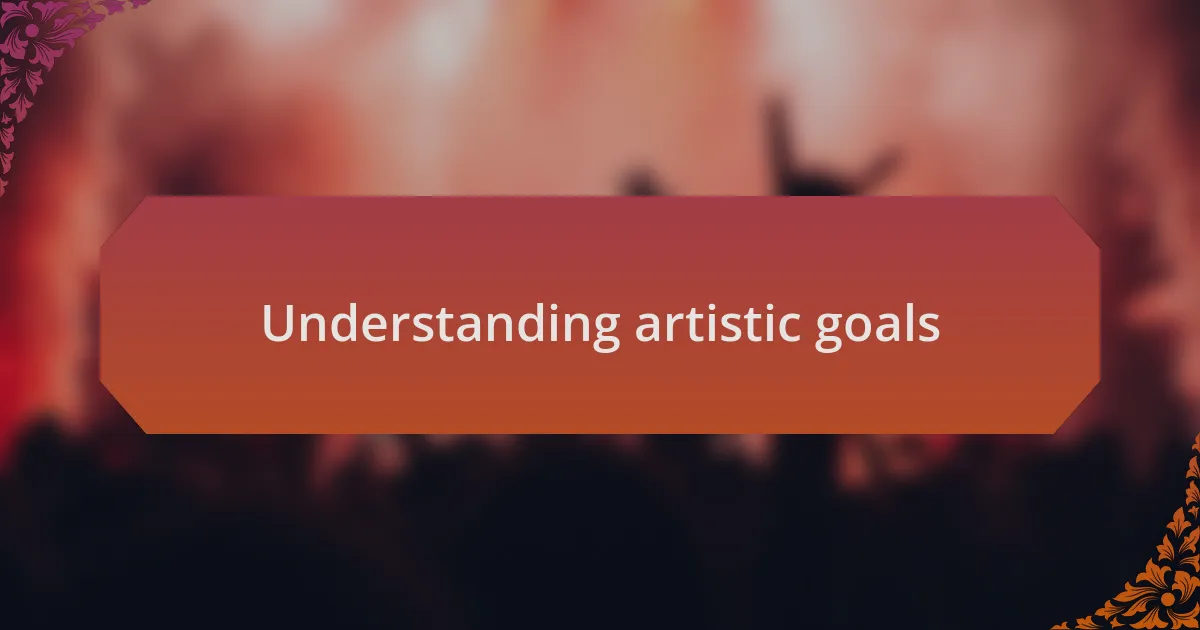
Understanding artistic goals
Artistic goals are more than just ambitions; they reflect your innermost beliefs and desires as a creator. I recall a time when I set out to produce an album that truly represented my journey. This experience taught me that your goals should resonate with your personal story and feelings, guiding your creative process.
When I think about what drives me artistically, I often ask myself, “What impact do I want my work to have?” This question can be profound, shaping everything from your sound to your visuals. It forces you to dive deep into the essence of your creative identity and encourages you to articulate your vision clearly.
Setting realistic artistic goals involves balancing aspirations with practicality. In my own experience, I’ve learned that while dreaming big is essential, breaking those dreams into achievable steps is what keeps the creative fire alive. Have you ever felt overwhelmed by your ambitions? I’ve found that setting smaller, targeted milestones not only makes the journey manageable but also provides a sense of accomplishment along the way.
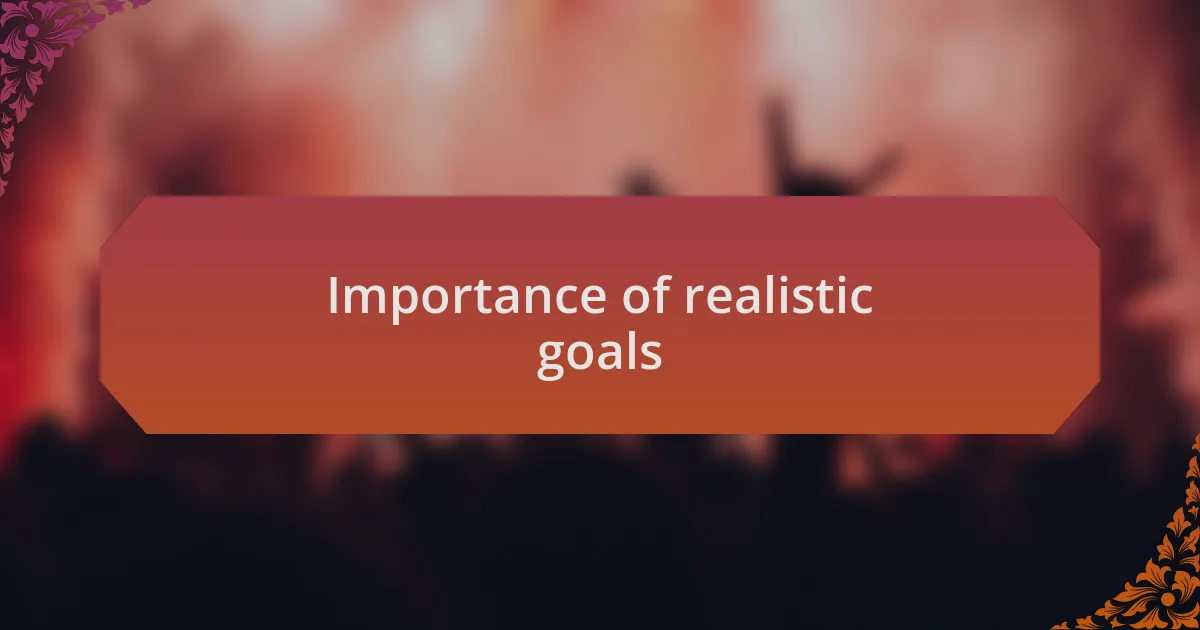
Importance of realistic goals
Setting realistic goals in the artistic realm is crucial for fostering creativity without suffocating it. When I first launched my independent record label, I envisioned reaching the top charts within a year. However, that lofty aim only led to frustration. It wasn’t until I broke my dream into manageable objectives, like networking with local artists and curating smaller shows, that I started to see progress.
Realistic goals serve as a compass, guiding artists through the often tumultuous journey of music creation. I remember a period when I focused solely on perfecting my sound, but without tangible targets, I felt lost. Once I set specific goals, like writing one new song each month or collaborating with a different artist quarterly, my creative output skyrocketed. Those clear, achievable steps rekindled my passion and kept me motivated.
Moreover, the importance of realistic goals extends beyond just reaching milestones; they nurture your resilience and adaptability as an artist. Have you ever faced setbacks that made you question your abilities? I have, and it was a commitment to my realistic goals that helped me bounce back each time. Embracing achievable aspirations reminded me that growth often comes from the journey, not just the destination.
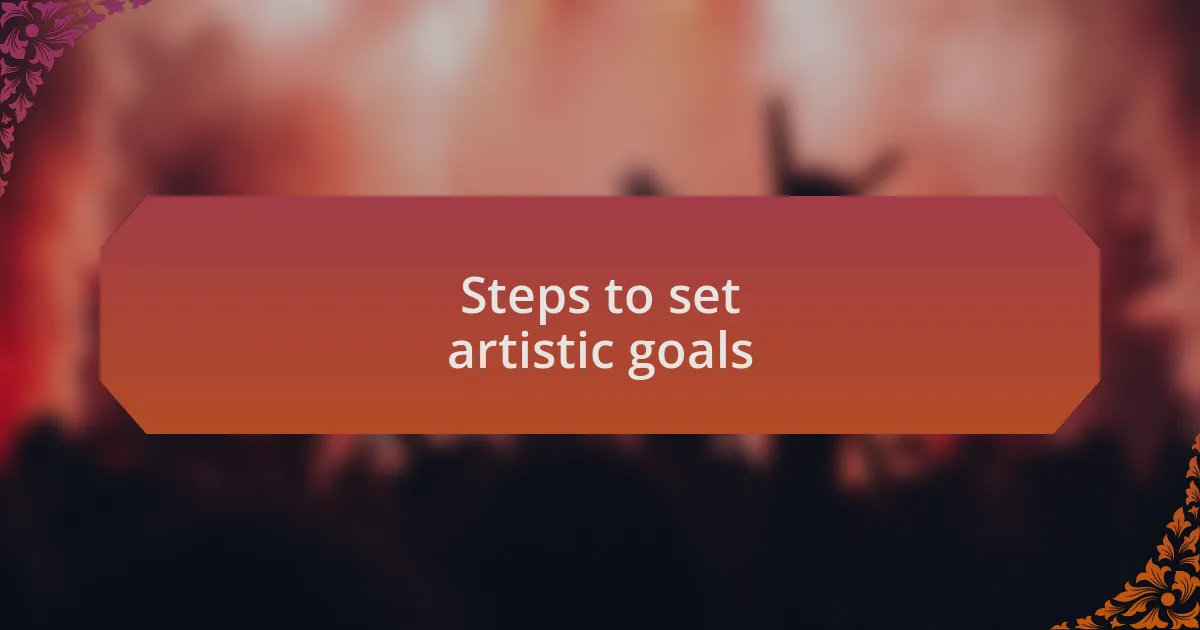
Steps to set artistic goals
When setting artistic goals, I find it essential to start with self-reflection. I often ask myself what truly inspires me, whether it’s a specific genre, a unique artistic flair, or a message I want to convey through my music. This personal introspection helps me formulate goals that resonate with my identity as an artist, ensuring that I’m not just chasing trends but nurturing my authentic voice.
Next, breaking down these broader aspirations into smaller, actionable steps is crucial. For instance, instead of telling myself I want to produce an entire album in a year—a daunting and often overwhelming task—I focus on creating one track every couple of months. This approach allows me to celebrate each completed piece, fostering a sense of accomplishment that fuels my creativity.
Finally, I always build in flexibility when planning my artistic goals. Life has its unpredictabilities, and I’ve learned that rigid timelines can lead to discouragement. There was a time when I aimed to release a single by a specific date, but unexpected challenges arose. By allowing space to adapt my goals, I not only ease the pressure but also open myself to new opportunities that enrich my creative journey. How do you adapt your goals when life takes an unexpected turn? I believe embracing change can lead to even greater artistic growth.
![]()
Tools for tracking progress
Tracking progress is an important part of achieving artistic goals. One tool I’ve found incredibly helpful is a simple checklist or a goal-tracking app. When I first began, I used a physical notebook; crossing off tasks not only provided a visual representation of my achievements but also created a sense of satisfaction. Have you ever experienced that moment of seeing your progress laid out in front of you? It can be incredibly motivating!
Another method I enjoy is updating a dedicated digital journal. Writing down my feelings about each milestone helps me dig deeper into my creative journey. For example, after finishing a challenging song, I take a moment to jot down not just the sense of completion but the emotions and thoughts I had during the creative process. Reflecting on these moments allows me to learn from my experiences, shaping my future goals. Isn’t it fascinating how our reflections can deepen our understanding of ourselves?
Finally, I can’t overstate the value of sharing progress with a supportive community. Whether it’s through social media or local music groups, getting feedback on my work gives me insight I might overlook on my own. Last year, I shared snippets of a track I was working on with fellow musicians, and their encouragement fueled my passion in ways I hadn’t expected. How often do we underestimate the power of community in our artistic endeavors? Being accountable to others often provides that little push we need to keep moving forward.
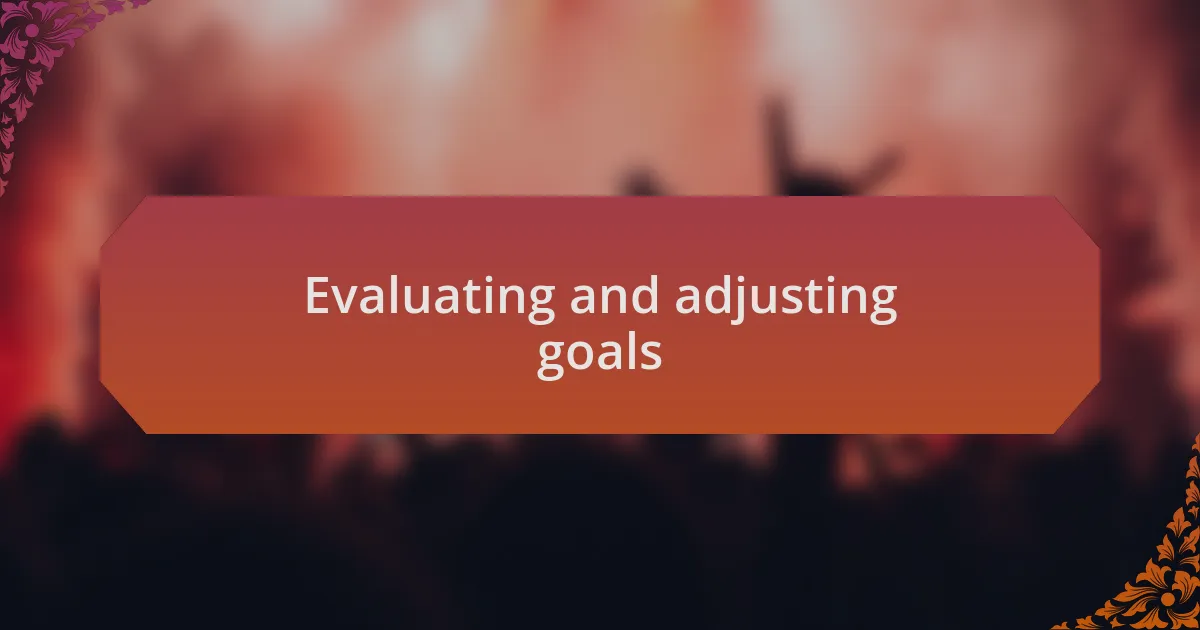
Evaluating and adjusting goals
As I continue on my artistic journey, I’ve found that regularly evaluating my goals is essential. It’s easy to become attached to your original vision, but sometimes, circumstances change. For instance, I once set a lofty goal to produce an entire album in three months. Halfway through, I realized I was sacrificing quality for speed, which wasn’t what I wanted. Have you ever felt the tension between ambition and artistry? In recognizing that, I adjusted my goal timeline, ultimately leading to a more meaningful creation.
When it comes to adjusting goals, I believe flexibility is key. I often revisit my objectives whenever I embark on new projects. One time, I had to reassess my collaboration expectations after a team member faced personal challenges. Instead of pushing through, we chose to redefine the goal, focusing on what we could achieve with the current circumstances. This adaptability told me that it’s okay to pivot; sometimes, the best outcomes arise from unexpected changes.
Evaluating our progress involves more than just numbers; it’s about emotions and growth. I remember a moment when I felt stuck and questioned if I was moving in the right direction. Reflecting on my journey, I realized I had overcome numerous hurdles that taught me resilience. What have your challenges taught you? Embracing setbacks as learning moments is crucial, allowing us to refine our goals based on what we truly need at each step.
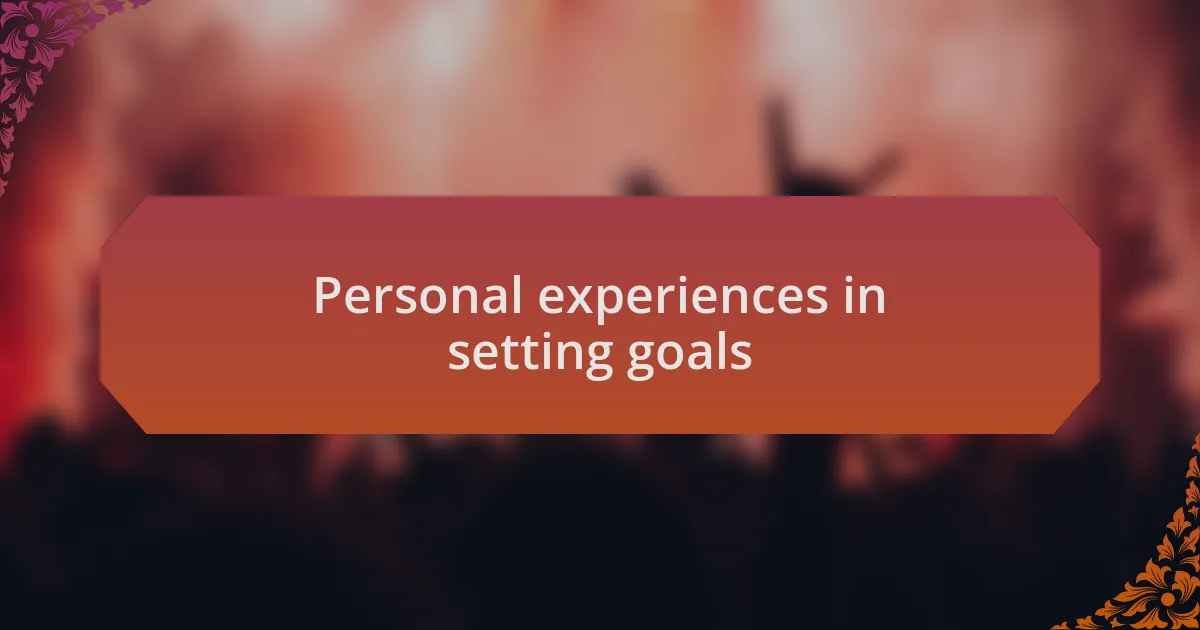
Personal experiences in setting goals
Setting goals has always been a deeply personal experience for me, shaped by my own artistic endeavors. I recall when I aimed to finish a music video in just two weeks. The excitement fueled my passion initially, but soon I found myself overwhelmed and losing sight of why I started in the first place. Have you ever rushed through creative work only to feel like something’s missing? By stepping back and allowing more time, I was able to reconnect with my vision and make something I was genuinely proud of.
In another instance, I discovered the importance of clear intentions behind my goals. I set out to play at several local venues, thinking it would bolster my presence in the community. After my first performance, however, I realized I needed to focus instead on building relationships rather than just numbers. Have you ever pursued an opportunity only to find it didn’t resonate with your core values? By reorienting my approach toward meaningful connections, I found that my artistic journey became more fulfilling.
Looking back, I’ve learned that goal-setting is not just about ticking boxes; it’s about self-discovery. I remember grappling with a decision to explore a genre outside my comfort zone. Initially, fear held me back, but embracing that challenge opened new avenues of creativity. What fears have you confronted in your own artistic path? Each risk I took not only expanded my skills but also deepened my understanding of what I truly wanted as an artist.
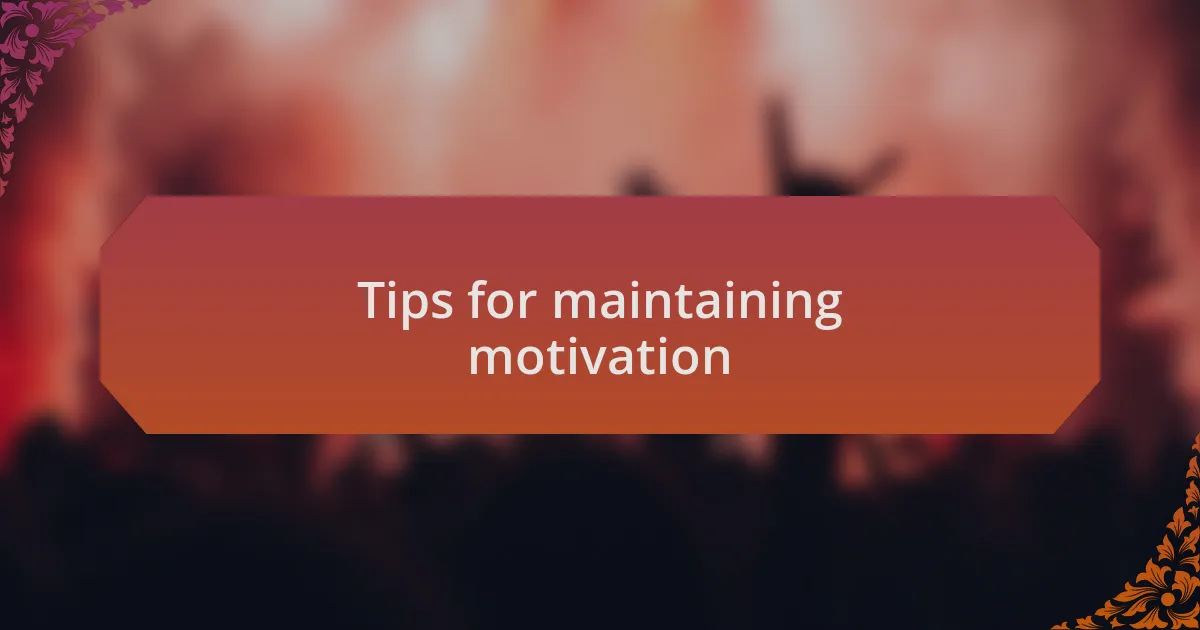
Tips for maintaining motivation
Maintaining motivation in the creative process can be a challenge, especially during tough stretches. I remember a time when I committed to writing a song every day for a month, convinced it would spark something amazing. However, as the days dragged on, I hit walls of frustration. When motivation wanes, I find it helps to connect with fellow artists for encouragement. Have you ever shared your struggles with someone who truly understands? That camaraderie can reignite your enthusiasm and remind you that creativity is a shared journey.
It’s crucial to celebrate small wins, even if they seem insignificant. I once completed a single verse of a song after a week of feeling blocked, and instead of dismissing it, I treated myself to something special—like a favorite meal or a small outing. Have you acknowledged your progress recently? Recognizing these little achievements not only boosts morale but reinforces the habit of creation.
Additionally, I’ve learned that diversifying my creative outlets can keep the inspiration flowing. During a particularly uninspired phase, I picked up painting again, something I hadn’t done in years. The colors and forms sparked new ideas for my music. What about you? Have you explored other forms of creativity that can infuse fresh energy into your primary art? Venturing into different artistic territories often reveals new dimensions to your work.